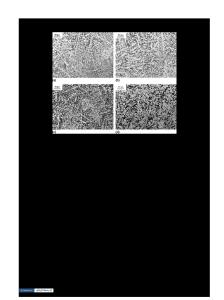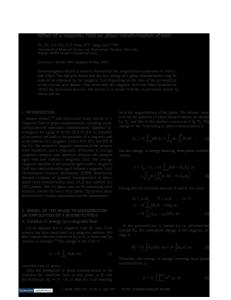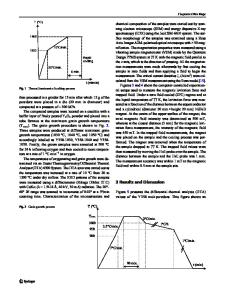Grain refinement effect of a pulsed magnetic field on as-cast superalloy K417
- PDF / 2,251,245 Bytes
- 7 Pages / 584.957 x 782.986 pts Page_size
- 55 Downloads / 305 Views
The grain refinement effect of a pulsed magnetic field on superalloy K417 was studied. The experimental results show that fine equiaxed grains are acquired with proper thermal control under the pulsed magnetic field. The refinement effect of the pulsed magnetic field is affected by the melt cooling rate and the melt superheating. The refinement effect of the pulsed magnetic field is attributed to the dissociation of nuclei from the mold wall by melt vibration and the subsequent dispersion of nuclei by melt convection. The Joule heat and the melt convection caused by the pulsed magnetic field may defer the formation of solidified shell, which prolongs the continuous refinement process. The decrease of melt cooling rate reduces the number of nuclei produced on the mold wall but prolongs the duration for the nuclei to depart from the mold wall and disperse in the melt, which enhances the refinement effect of the pulsed magnetic field. The increase of melt superheating lessens the survival probability of the nuclei in the melt, which weakens the refinement effect of the pulsed magnetic field.
I. INTRODUCTION
The investment casting of superalloy tends to produce coarse grains, which is favorable to the creep deformation property. However, in practice, many components are damaged because of high temperature fatigue. Therefore, it is desired to increase the ability against fatigue. The fatigue property can be effectively improved by grain refinement. Fine grain casting of superalloy mainly includes the thermal control method, the chemical approach, and the dynamic method. The principle of the thermal control method1 is to refine the microstructure by lowering refining temperature and pouring temperature, as well as by increasing cooling rate. With the chemical approach,2,3 the rate of heterogeneous nucleation is increased by adding solid grain refinement agent into the melt. The thermal control method worsens pourability and the chemical approach changes chemical compositions of alloys. Therefore, the dynamic method arouses much attention. The dynamic method4,5 introduces an external force to melt during solidification. The force drives the melt flow by which solidified dendrites are broken, nuclei are increased, and finally the microstructure is refined. The prevalent dynamic methods include the Grainex method, which refines grains by using a circumrotating casting mold, and the Microcast method, which couples mechanical stirring and fast solidification. The application of the Grainex method is used in revolving a)
Address all correspondence to this author. e-mail: [email protected] DOI: 10.1557/JMR.2009.0326
2670
http://journals.cambridge.org
J. Mater. Res., Vol. 24, No. 8, Aug 2009 Downloaded: 12 Mar 2015
body and lager section body casting. Besides, high temperature isostatic pressing is needed to decrease the porosity in the casting. The Microcast method requires low pouring temperature, which is difficult to achieve. Until now, new methods are still needed to refine as-cast microstructure of superalloy more effi
Data Loading...











